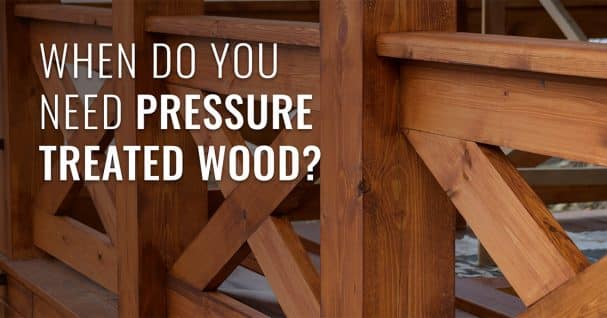
Perhaps you’ve already heard of pressure treated plywood. Demand for this particular wood has increased over the past year due to the pandemic and interest in building outdoor structures that can withstand heavy rain, humidity, and plenty of use. Families took on projects for outdoor decks and other structures they could safely use for gatherings when social distancing was a must. But why is pressure treated wood the material of choice for these projects and are there alternatives? We’ve got the answers to all your questions here.
What Is Pressure Treated Plywood?
While the name is self-explanatory, the process and reasoning behind it are not as obvious. Pressure treating is when a chemical preservative is infused into the wood — most often, a Southern Yellow Pine — using a pressurizing tank. This treatment increases the lifespan of the wood, making it an extremely durable material resistant to insects, rodents, sun damage, mold, and mildew.
Different manufacturers use different chemical preservatives, but the one most people are familiar with is chromated copper arsenate (CCA). This particular chemical finds itself in the spotlight because of concerns over how it can affect people and animals. It contains arsenic, which in high doses is harmful, and builders shy away from using pressure treated plywood with CCA on high-touch projects, like playgrounds or garden beds.
While the research on CCA’s effect on a person’s health is relatively limited, there are safer chemical preservatives available, including amine copper quat (ACQ) and copper azole (CA). Humans and animals are unable to absorb copper, as opposed to arsenic, which is why these treatments are becoming much more popular. All of this is to say, plywood treated with any of these preservatives is a safe building material when used correctly.
Common Uses for Pressure Treated Wood
Given that it’s highly durable, pressure treated plywood is most commonly used to build outdoor decks, fences, and railings. The American Wood Protection Association created a helpful tool to help determine the best wood for your project based on three categories: ground contact, above-ground, and marine use.
Ground contact projects include: structural posts (like support beams for a porch), stairs, planter box, permanent foundation, posts, landscape or retaining walls, and deck posts. Above-ground uses are considered siding and trim, shingles, porch and deck flooring, stairs, deck railings, and sill plates or subflooring (interior construction where water is a concern). Marine use includes boats and other marine projects such as docks. Other than subflooring or interior support, it’s not recommended to use pressure treated plywood indoors.
The grading system for pressure treated woods serves two purposes: determining the correct amount of preservative needed for a project and the safety of each grade. For instance, a flower bed or retaining wall using pressure treated wood will require more durability because of its contact with soil, but the soil will also gradually absorb some of the preservatives, requiring extra care. No matter which grade of pressure treated plywood you use, we recommend avoiding direct contact with it while building by wearing gloves, a face mask, and long sleeves and pants.
Alternatives to Pressure Treated Plywood
Using pressure treated plywood isn’t scary or unsafe when taking the proper precautions. However, there are alternatives that are durable and have similar insect and water resistant properties. One option is simply to treat the wood with an oil-based sealant to help prevent the preservatives from reaching the wood’s surface.
However, if pressure treated plywood is in low supply, which many markets are currently facing, or you’d prefer not to use it, you don’t need to forgo any building projects because the alternatives are plenty. A popular choice among builders and DIYers is cedar because it is naturally resistant to insects and holds up well outdoors. Cedar does not need to be treated — in fact, treatment will cover its natural oils, making it less durable and resistant to the elements. Using cedar for high traffic areas, like building decks and playgrounds, is a great option if you’d like a natural wood that is durable, safe, and low-maintenance.
Similar to cedar, bamboo and bamboo composites are popular for outdoor and ground-contact uses because of its sustainability; bamboo grows quickly and in almost any environment. It’s become a popular choice for decks, as well as furniture and framing materials. Other non-wood alternatives include composites, which are made of recycled plastics and made to give the appearance of a painted or treated wood, aluminum, which is most often used in commercial projects, like apartment balconies, because it is sturdy, requires little maintenance, and is easy to assemble. Similar to aluminum is vinyl; it holds up well under even the most extreme weather conditions and is a popular choice for siding, decking, or projects where it needs to be attached to wood or composite framing materials.
There’s little reason to be weary of pressure treated plywood. What’s more important is that you know what materials are available to you, based on your particular project. Choose the wood or alternative that you’ll be most comfortable with in the long-term, because the last thing you’ll want to do is regularly rebuild something that’s meant to last decades.



